Experimental Investigation on Plume Characteristics of PTFE-Filled Carbon, Graphite, Graphene for Laser-Assisted Pulsed Plasma Thruster
Abstract
:1. Introduction
2. Experiments
2.1. Experiment System
2.2. Preparation of Doped Propellants
2.3. Image Processing Method
3. Results
3.1. Plume Images
3.2. Plume Parameters
3.3. Graphene Fraction Dependence of Plume Characteristics
4. Conclusions
Author Contributions
Funding
Institutional Review Board Statement
Informed Consent Statement
Data Availability Statement
Conflicts of Interest
References
- Levchenko, I.; Bazaka, K.; Mazouffre, S.; Xu, S. Prospects and Physical Mechanisms for Photonic Space Propulsion. Nat. Photon. 2018, 12, 649–657. [Google Scholar] [CrossRef]
- Ou, Y.; Zhang, Y.; Wu, J.; Li, J.; Tan, S.; Zhao, Y. Comparative Study of PTFE Filled Different Dopants as Propellants for Laser-Electric Hybrid Thruster. Acta Astronaut. 2021, 183, 199–210. [Google Scholar] [CrossRef]
- Yu, H.; Li, Y.; Ji, Y.; Wu, X.; Yuan, Y.; Li, H.; Yang, J. The Propulsion Mechanism and Tiny Particles Removal Investigation Based on the “Micro-Gun” Propulsion System. Opt. Laser Technol. 2019, 119, 105627. [Google Scholar] [CrossRef]
- Gurin, A.V.; Kuvaev, K.Y.; Loktionov, E.Y.; Protasov, Y.S.; Sirenko, K.N.; Zakharov, V.I. First Attempt of a Laser Thruster Space Flight Test: Lost at Launch. Opt. Laser Technol. 2019, 120, 105656. [Google Scholar] [CrossRef]
- Wu, Z.; Huang, T.; Liu, X.; Ling, W.Y.L.; Wang, N.; Ji, L. Application and Development of the Pulsed Plasma Thruster. Plasma Sci. Technol. 2020, 22, 094014. [Google Scholar] [CrossRef]
- Liu, H.; Niu, X.; Li, X.; Lu, H. Reviews on Electrical Propulsion Technology Using Iodine Alternatives. J. Propuls. Technol. 2019, 40, 12–25. [Google Scholar] [CrossRef]
- Dietz, P.; Gärtner, W.; Koch, Q.; Köhler, P.E.; Teng, Y.; Schreiner, P.R.; Holste, K.; Klar, P.J. Molecular Propellants for Ion Thrusters. Plasma Sources Sci. Technol. 2019, 28, 084001. [Google Scholar] [CrossRef]
- Ou, Y.; Wu, J.; Zhang, Y. Design and Experimental Results of a Laser-Ignited Solid-Propellant-Fed Magnetoplasmadynamic Thruster. Rev. Sci. Instrum. 2020, 91, 074501. [Google Scholar] [CrossRef]
- Ou, Y.; Wu, J.; Zhang, Y.; Li, J.; Tan, S. Theoretical Modeling and Parameter Analysis of Micro-Pulsed Plasma Thruster. Energies 2018, 11, 1146. [Google Scholar] [CrossRef]
- Kamimura, T.; Tahara, H. R&D, Launch and Initial Operation of the Osaka Institute of Technology 1st PROITERES Nano-Satellite with Electrothermal Pulsed Plasma Thrusters and Development of the 2nd and 3rd Satellites. In Proceedings of the 50th AIAA/ASME/SAE/ASEE Joint Propulsion Conference; American Institute of Aeronautics and Astronautics, Cleveland, OH, USA, 28 July 2014. [Google Scholar]
- Manente, M.; Trezzolani, F.; Magarotto, M.; Fantino, E.; Selmo, A.; Bellomo, N.; Toson, E.; Pavarin, D. REGULUS: A Propulsion Platform to Boost Small Satellite Missions. Acta Astronaut. 2019, 157, 241–249. [Google Scholar] [CrossRef]
- Kim, D.; Jerjen, H.; Geha, M.; Chiti, A.; Milone, A.P.; Costa, G.D.; Mackey, D.; Frebel, A.; Conn, B. Portrait of a Dark Horse: A Photometric and Spectroscopic Study of the Ultra-Faint Milky Way Satellite Pegasus III. Astrophys. J. 2016, 833, 16. [Google Scholar] [CrossRef]
- Li, Y.; Dai, J.; Zhao, C.; Zhang, S. Research on Rapid Batch Test of Whole Star Based on Pulsating Production Line. J. Phys. Conf. Ser. 2022, 2252, 012015. [Google Scholar] [CrossRef]
- Lev, D.; Myers, R.M.; Lemmer, K.M.; Kolbeck, J.; Koizumi, H.; Polzin, K. The Technological and Commercial Expansion of Electric Propulsion. Acta Astronaut. 2019, 159, 213–227. [Google Scholar] [CrossRef]
- Huang, T.; Wu, Z.; Sun, G.; Liu, X.; Ling, W.Y.L. Study and Modeling of Propellant Ablation in Coaxial Ablative Pulsed Plasma Thrusters. Acta Astronaut. 2020, 173, 69–75. [Google Scholar] [CrossRef]
- Ling, W.Y.L.; Schönherr, T.; Koizumi, H. Characteristics of a Non-Volatile Liquid Propellant in Liquid-Fed Ablative Pulsed Plasma Thrusters. J. Appl. Phys. 2017, 121, 073301. [Google Scholar] [CrossRef]
- Ziemer, J.; Cubbin, E.; Choueiri, E.; Birx, D.; Ziemer, J.; Cubbin, E.; Choueiri, E.; Birx, D. Performance Characterization of a High Efficiency Gas-Fed Pulsed Plasma Thruster. In Proceedings of the 33rd Joint Propulsion Conference and Exhibit; American Institute of Aeronautics and Astronautics, Seattle, WA, USA, 6 July 1997. [Google Scholar]
- Ling, W.Y.L.; Zhang, S.; Fu, H.; Huang, M.; Quansah, J.; Liu, X.; Wang, N. A Brief Review of Alternative Propellants and Requirements for Pulsed Plasma Thrusters in Micropropulsion Applications. Chin. J. Aeronaut. 2020, 33, 2999–3010. [Google Scholar] [CrossRef]
- Zhao, Y.; Tan, S.; Wu, J.; Zhang, Y.; Ou, Y.; Zheng, P. The Ablation Characteristics of Laser-Assisted Pulsed Plasma Thruster with Metal Propellant. Plasma Sci. Technol. 2021, 23, 104007. [Google Scholar] [CrossRef]
- Yu, H.; Li, H.; Wang, Y.; Cui, L.; Liu, S.; Yang, J. Brief Review on Pulse Laser Propulsion. Opt. Laser Technol. 2018, 100, 57–74. [Google Scholar] [CrossRef]
- Ou, Y.; Wu, J.; Zhang, Y.; Li, J. Modeling the Laser-Polymer Interaction of Laser Propulsion Systems Considering Progressive Surface Removal, Thermal Decomposition and Non-Fourier Effect. Acta Astronaut. 2021, 186, 319–328. [Google Scholar] [CrossRef]
- Ou, Y.; Wu, J.; Zhang, Y.; Li, J. Comparative Study of Plume Characteristics of Polymeric Propellants Filled with Different Oxides for Laser-Electric Hybrid Thruster. Opt. Laser Technol. 2022, 147, 107609. [Google Scholar] [CrossRef]
- Ou, Y.; Wu, J.; Du, X.; Zhang, H.; He, Z. Experimental Investigation on Characteristics of Pulsed Plasma Thrusters with the Propellant Samples of Modified PTFE Filled Si, Al and Al2O3. Vacuum 2019, 165, 163–171. [Google Scholar] [CrossRef]
- Zhang, H.; Duan, B.; Wu, L.; Hua, Z.; Bao, Z.; Guo, N.; Ye, Y.; Galfetti, L.; DeLuca, L.T.; Shen, R. Actualization of an Efficient Throttleable Laser Propulsion Mode. Energy 2021, 221, 119870. [Google Scholar] [CrossRef]
- Ding, T.; Guo, W.; Cao, W.; Pei, H.; Zheng, X.; Liu, C. Experimental Study of Reaction Properties of Aluminum/Polytetrafluoroethylene Powder under Laser Ablation. AIP Adv. 2021, 11, 085010. [Google Scholar] [CrossRef]
- Küper, S.; Stuke, M. Ablation of Polytetrafluoroethylene (Teflon) with Femtosecond UV Excimer Laser Pulses. Appl. Phys. Lett. 1989, 54, 4–6. [Google Scholar] [CrossRef]
- Mitra, A.; Thareja, R.K. Determination of Laser Ablation Threshold of Teflon at Different Harmonics of Nd:YAG Laser Using Photothermal Deflection Technique. J. Mater. Sci. 1999, 34, 615–619. [Google Scholar]
- Zhang, Y. Theoretical and Experimental Investigation on the Property of Propellant Ablation and Propulsion Performance of Laser Ablation Magnetoplasmadynamic Thruster. Ph.D. Thesis, National University of Defense Technology, Changsha, China, 2018. [Google Scholar]
- Tan, S.; Wang, M.; Wu, J.; Zhang, Y.; Li, J. A Study on the Plasma Plume Expansion Dynamics of Nanosecond Laser Ablating Al/PTFE. Energies 2020, 13, 3321. [Google Scholar]
- Duan, B.; Zhang, H.; Hua, Z.; Wu, L.; Bao, Z.; Guo, N.; Ye, Y.; Shen, R. Impulse and Electric Charge Characteristics of Chemical Propellant under Pulsed Laser Irradiation. Vacuum 2021, 192, 110419. [Google Scholar] [CrossRef]
- Ou, Y.; Wu, J.; Zhang, Y.; Li, J.; Zhao, Y. Plume Characteristics of Polymeric Material Doped with Different Metal Particles under Pulsed Laser Irradiation. Opt. Laser Technol. 2022, 152, 108132. [Google Scholar] [CrossRef]
- Ou, Y.; Wu, J.; Zhang, Y. Effects of Carbon, Graphite, and Graphene as Propellant Dopants in a Laser-Electric Hybrid Acceleration System. Opt. Laser Technol. 2022, 151, 108007. [Google Scholar] [CrossRef]
- Sinko, J.E.; Pakhomov, A.V.; Millen, S.; Zhu, J.; Sinko, R.J.; Potts, K.; Pakhomov, A.V. Delrin® for Propulsion with CO2 Laser: Carbon Doping Effects. AIP Conference Proceedings; AIP: Kailua-Kona, HI, USA, 2008; Volume 997, pp. 254–265. [Google Scholar]
- Pakhomov, A.V.; Mahaffy, K.E.; Pakhomov, A.V. Binary Solid Propellants for Constant Momentum Missions. AIP Conference Proceedings; AIP: Kailua-Kona, HI, USA, 2008; Volume 997, pp. 266–279. [Google Scholar]
- Wei, L.-Q.; Li, W.-B.; Ding, Y.-J.; Zhu, X.-M.; Wang, Y.-F.; Hu, J.-F.; Yan, S.-L.; Yu, D.-R. A Photographic Method for In-Orbit Measurement of Electron Temperature Distribution in the Plume of Hall Thrusters. Plasma Sources Sci. Technol. 2018, 27, 084002. [Google Scholar] [CrossRef]
- Han, X.; Wang, Y.; Chen, Z.; Wang, Y.; Wu, J.; Li, Z.; Tang, H.; Cao, J. High-Resolution Particle Density Measurement for Argon Plasma Plume by Image Reconstruction and Collisional-Radiative Model. Opt. Laser Technol. 2023, 167, 109544. [Google Scholar] [CrossRef]
- Kumar, A.; Singh, R.K.; Subramanian, K.P.; Patel, B.G.; Sunil, S.; Prajapati, I.A. Effects of Ambient Pressure and Laser Fluence on the Temporal Evolution of 426.7 Nm CII Line in Laser-Blow-off of Multilayered LiF-C Thin Film. J. Phys. D Appl. Phys. 2006, 39, 4860–4866. [Google Scholar] [CrossRef]
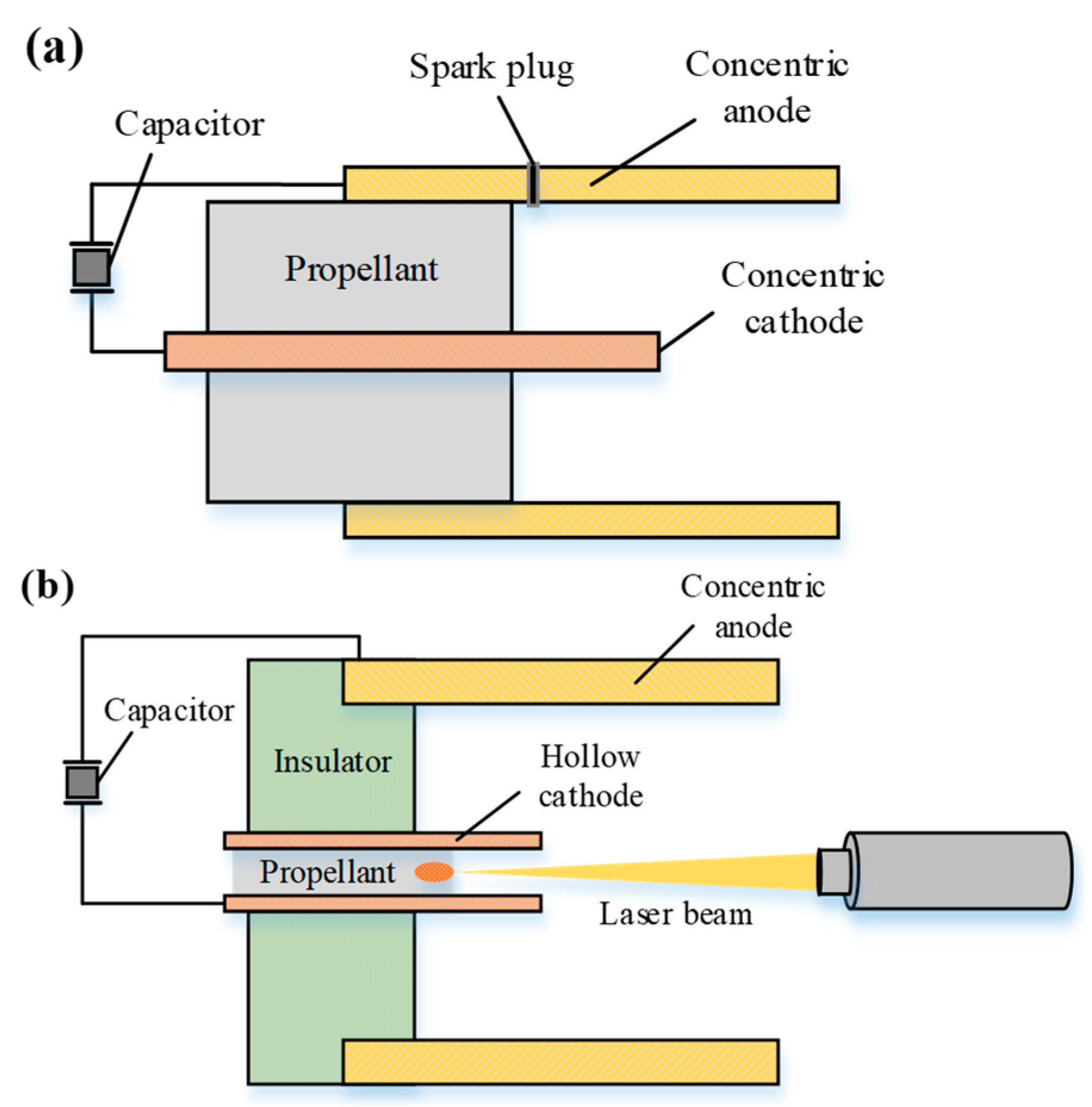
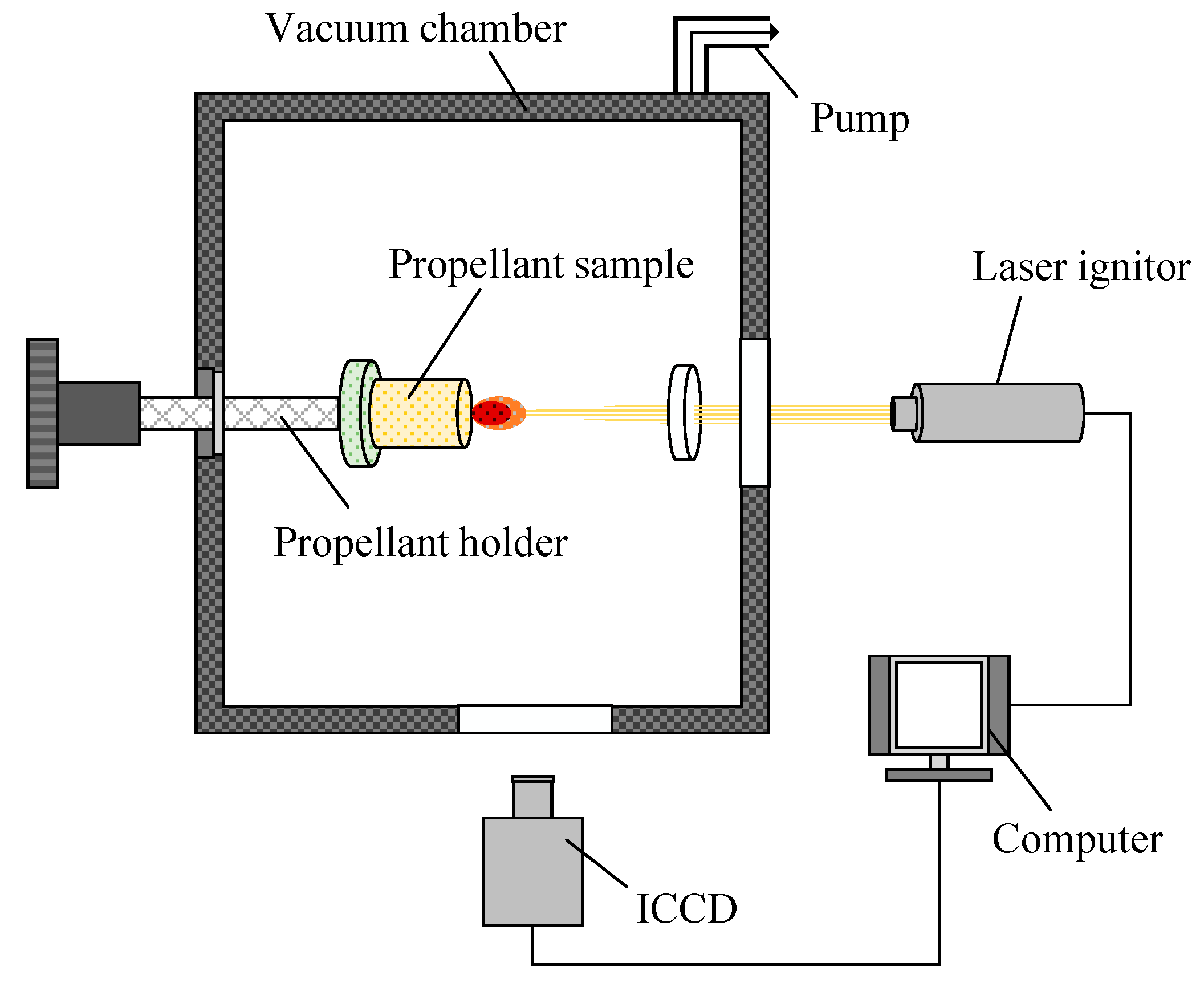
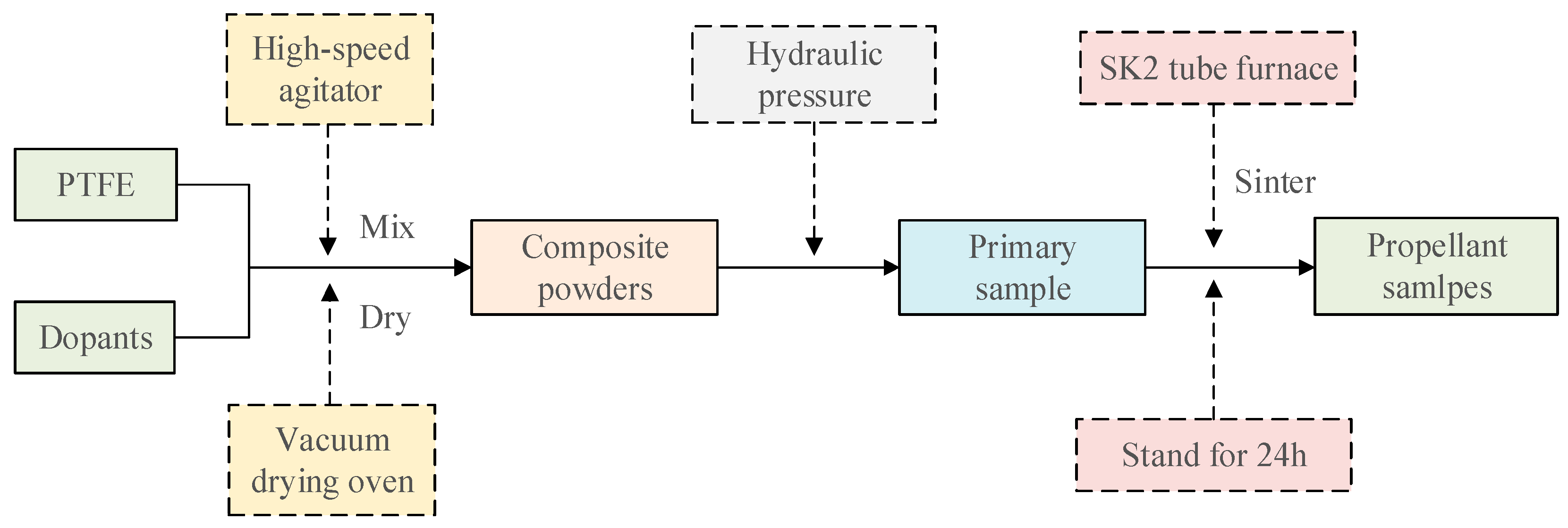
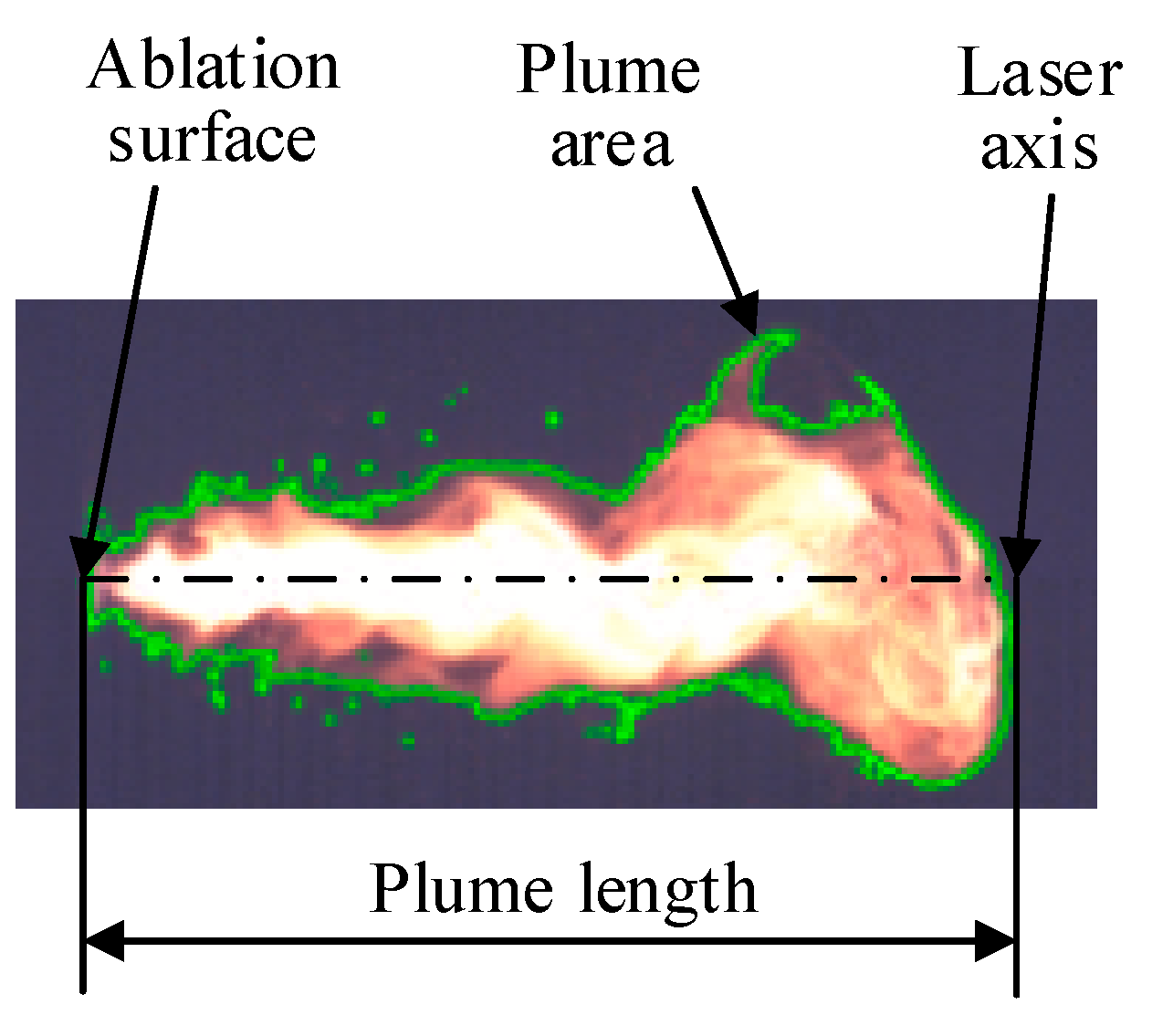

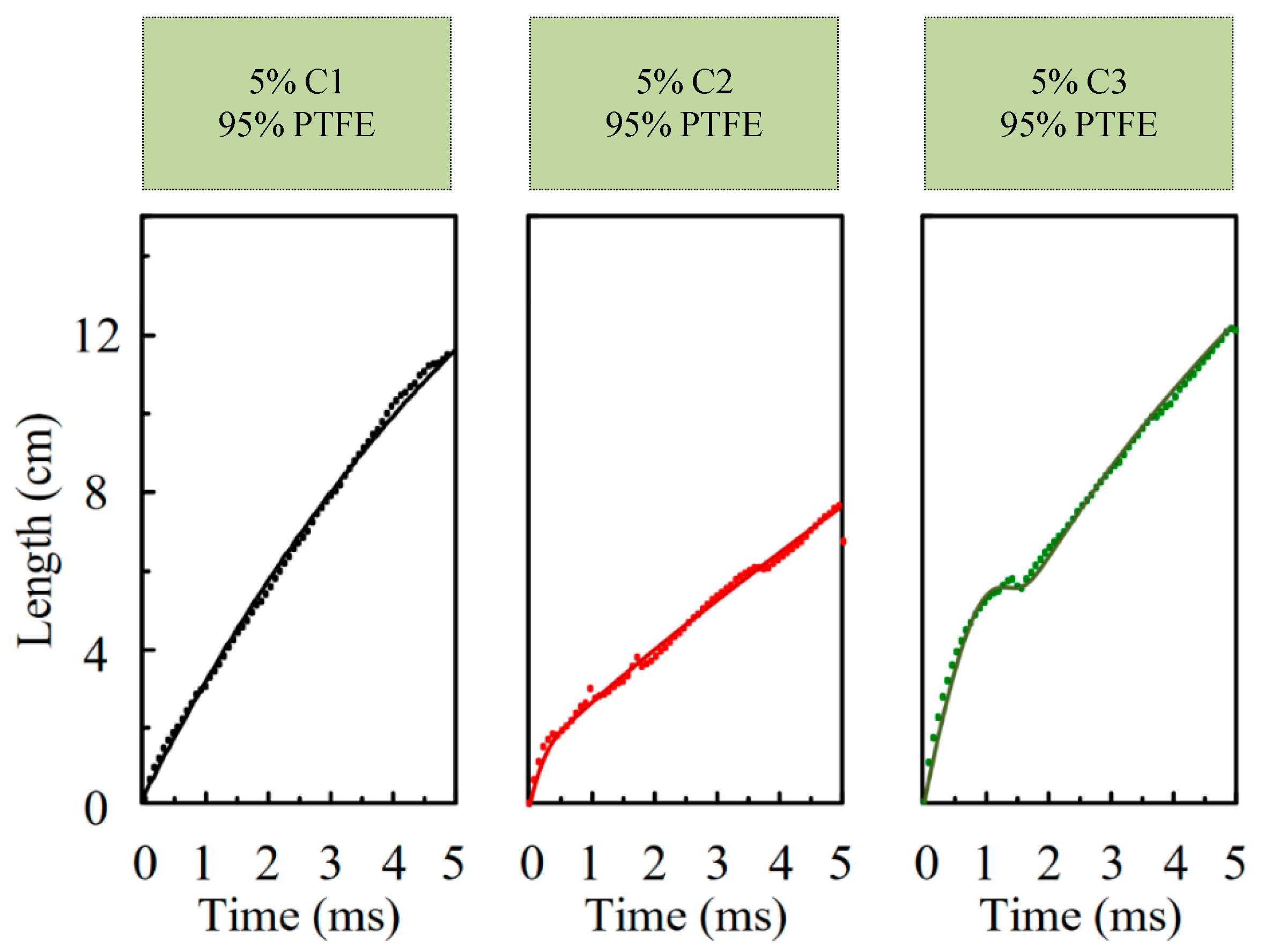
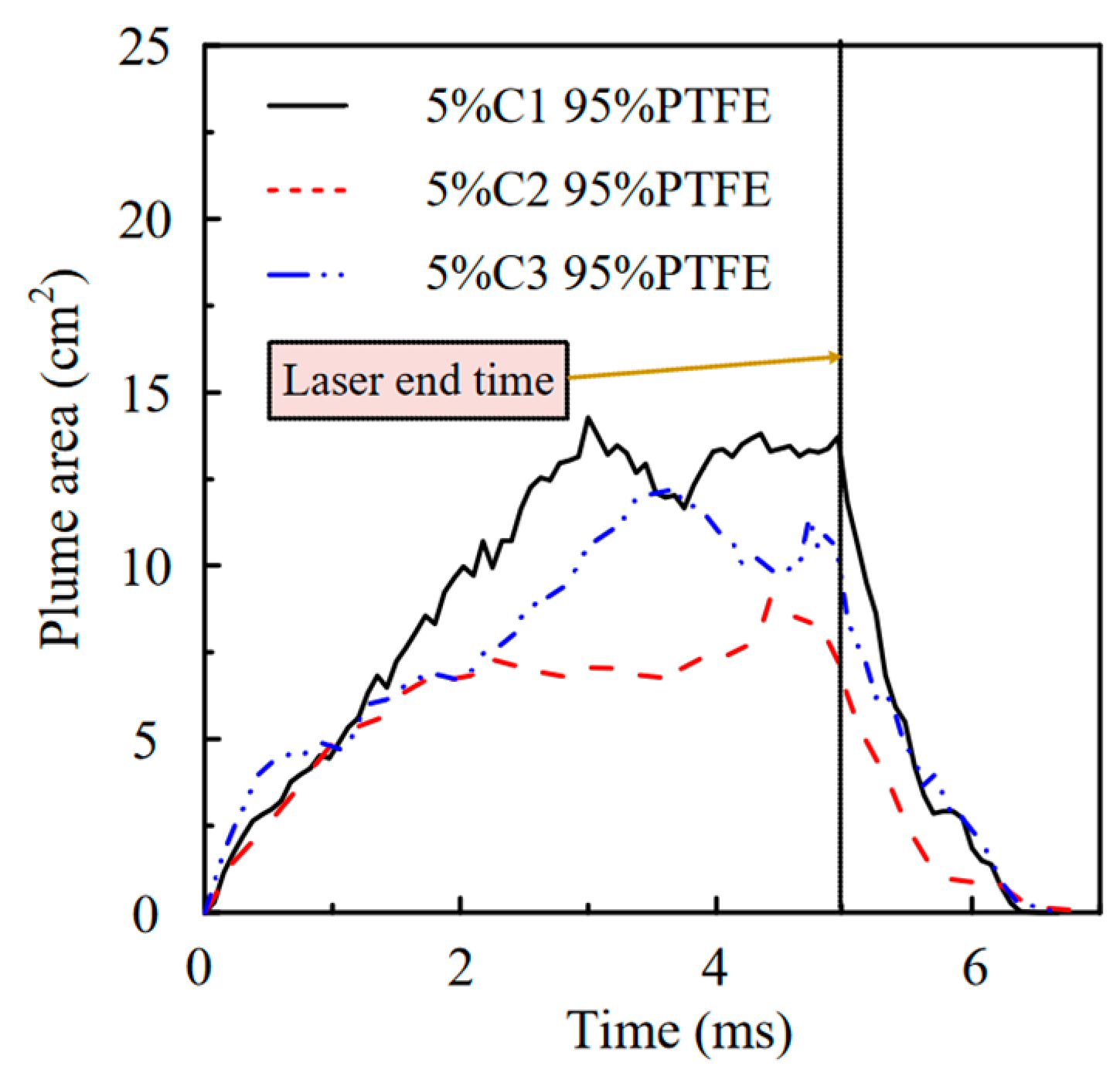
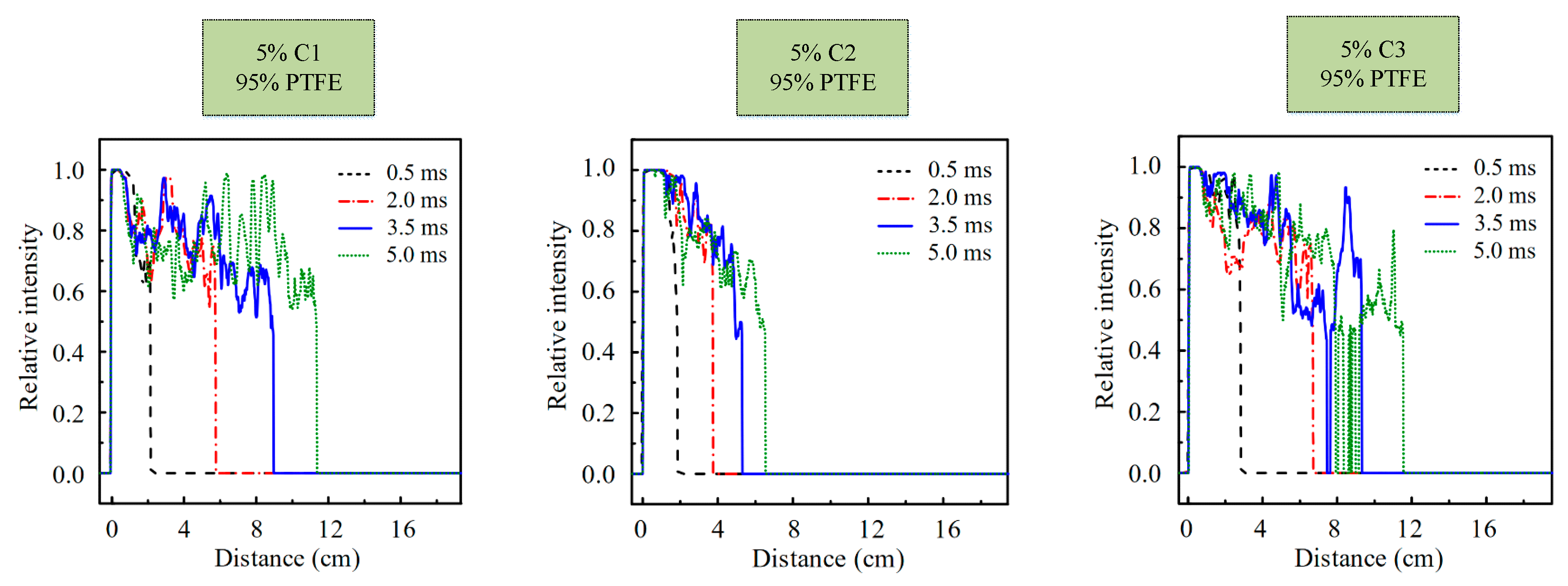
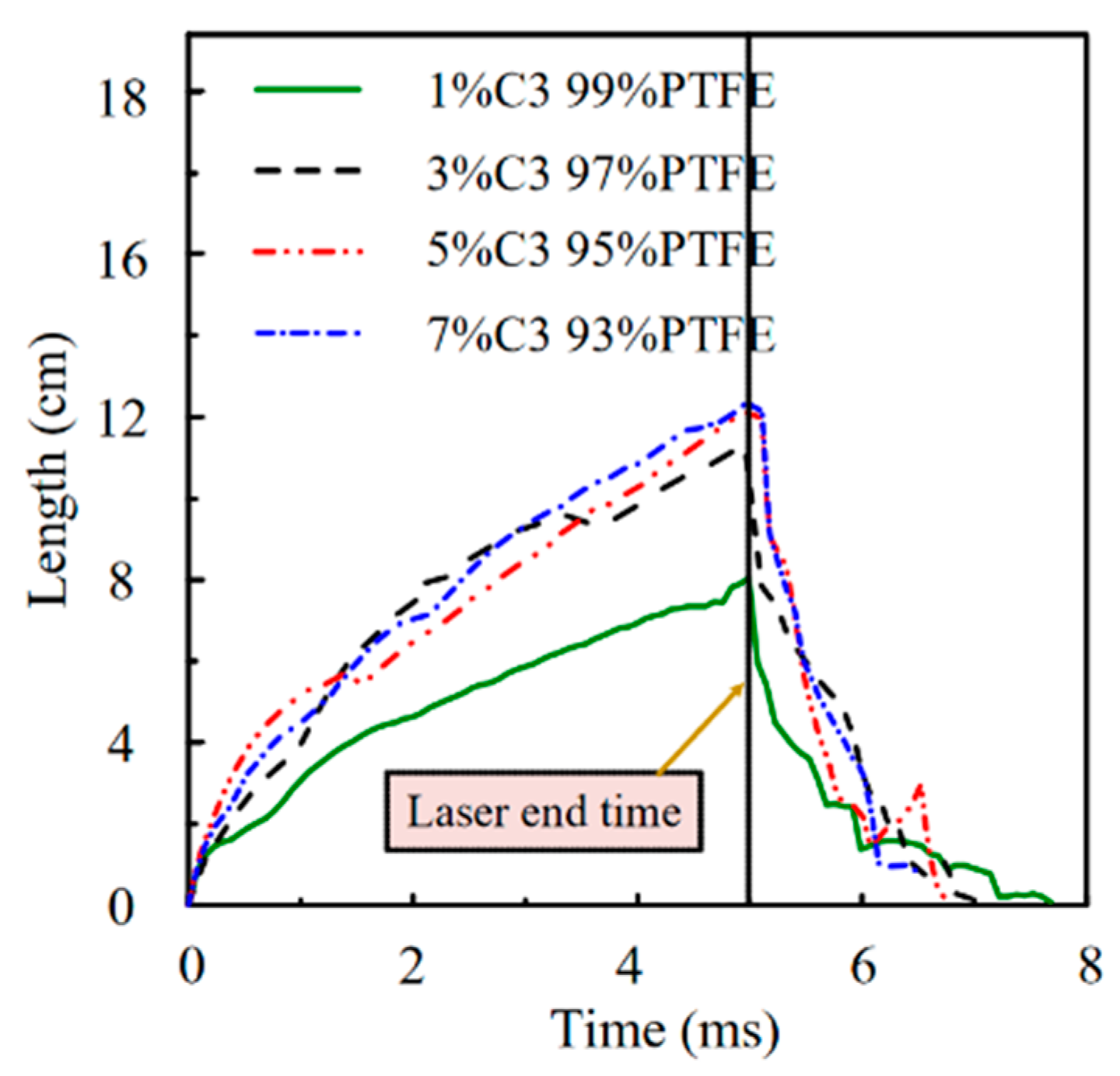

| Materials | Size | Company | Color | Melting Point |
|---|---|---|---|---|
| Nano-carbon powder (C1) | 30 nm | Beijing Dknano | Black | 3830 K |
| Graphite powder (C2) | 30 nm | Beijing Dknano | Black | 3925 K |
| Graphene powder (C3) | 1.2 nm | Beijing Dknano | Black | 4125 K |
| PTFE powder | 25 μm | American 3M | White | 600 K |
Disclaimer/Publisher’s Note: The statements, opinions and data contained in all publications are solely those of the individual author(s) and contributor(s) and not of MDPI and/or the editor(s). MDPI and/or the editor(s) disclaim responsibility for any injury to people or property resulting from any ideas, methods, instructions or products referred to in the content. |
© 2023 by the authors. Licensee MDPI, Basel, Switzerland. This article is an open access article distributed under the terms and conditions of the Creative Commons Attribution (CC BY) license (https://creativecommons.org/licenses/by/4.0/).
Share and Cite
Li, Y.; Ou, Y.; Wu, J.; Zhang, Y. Experimental Investigation on Plume Characteristics of PTFE-Filled Carbon, Graphite, Graphene for Laser-Assisted Pulsed Plasma Thruster. Appl. Sci. 2023, 13, 9283. https://doi.org/10.3390/app13169283
Li Y, Ou Y, Wu J, Zhang Y. Experimental Investigation on Plume Characteristics of PTFE-Filled Carbon, Graphite, Graphene for Laser-Assisted Pulsed Plasma Thruster. Applied Sciences. 2023; 13(16):9283. https://doi.org/10.3390/app13169283
Chicago/Turabian StyleLi, Yuqi, Yang Ou, Jianjun Wu, and Yu Zhang. 2023. "Experimental Investigation on Plume Characteristics of PTFE-Filled Carbon, Graphite, Graphene for Laser-Assisted Pulsed Plasma Thruster" Applied Sciences 13, no. 16: 9283. https://doi.org/10.3390/app13169283




